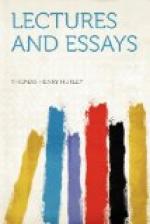Apart from the few fragmentary remains from the English greensand, to which I have referred, the Mesozoic rocks, older than those in which Hesperornis and Ichthyornis have been discovered have afforded no certain evidence of birds, with the remarkable exception of the Solenhofen slates. These so-called slates are composed of a fine grained calcareous mud which has hardened into lithographic stone, and in which organic remains are almost as well preserved as they would be if they had been imbedded in so much plaster of Paris. They have yielded the Archaeopteryx, the existence of which was first made known by the finding of a fossil feather, or rather of the impression of one. It is wonderful enough that such a perishable thing as a feather, and nothing more, should be discovered; yet for a long time, nothing was known of this bird except its feather. But by and by a solitary skeleton was discovered which is now in the British Museum. The skull of this solitary specimen is unfortunately wanting, and it is therefore uncertain whether the Archaeopteryx possessed teeth or not.[2] But the remainder of the skeleton is so well preserved as to leave no doubt respecting the main features of the animal, which are very singular. The feet are not only altogether bird-like, but have the special characters of the feet of perching birds, while the body had a clothing of true feathers. Nevertheless, in some other respects, Archaeopteryx is unlike a bird and like a reptile. There is a long tail composed of many vertebrae. The structure of the wing differs in some very remarkable respects from that which it presents in a true bird. In the latter, the end of the wing answers to the thumb and two fingers of my hand; but the metacarpal bones, or those which answer to the bones of the fingers which lie in the palm of the hand, are fused together into one mass; and the whole apparatus, except the last joints of the thumb, is bound up in a sheath of integument, while the edge of the hand carries the principal quill feathers. In the Archaeopteryx, the upper-arm bone is like that of a bird; and the two bones of the fore-arm are more or less like those of a bird, but the fingers are not bound together—they are free. What their number may have been is uncertain; but several, if not all, of them were terminated by strong curved claws, not like such as are sometimes found in birds, but such as reptiles possess; so that, in the Archaeopteryx, we have an animal which, to a certain extent, occupies a midway place between a bird and a reptile. It is a bird so far as its foot and sundry other parts of its skeleton are concerned; it is essentially and thoroughly a bird by its feathers; but it is much more properly a reptile in the fact that the region which represents the hand has separate bones, with claws resembling those which terminate the fore-limb of a reptile. Moreover, it had a long reptile-like tail with a fringe of feathers on each side; while, in all true birds hitherto known, the tail is relatively short, and the vertebrae which constitute its skeleton are generally peculiarly modified.




